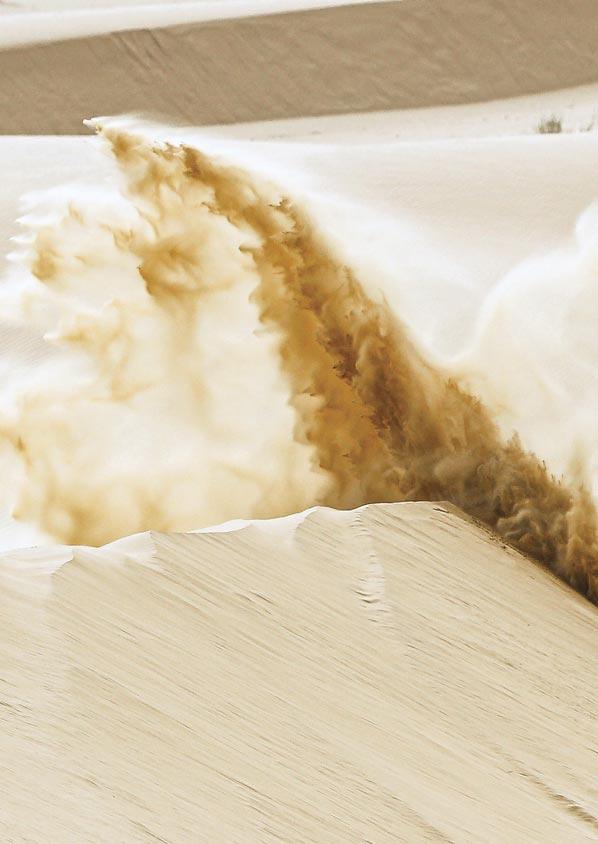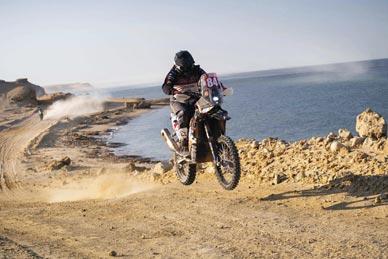
7 minute read
Former Recovery Mechanic takes on the 2021 DAKAR RALLY
Neil Hawker’s lifetime ambition was to complete the Dakar Rally - the hardest rally in the world. Since 2019, the rally has been held in Saudi Arabia where 100s of professionals and amateurs gather for the ultimate off-road endurance event. In this month’s magazine, Neil talks about why the Dakar Rally is so special and the reality of taking part in it.

Advertisement

Neil Hawker recently returned from Saudi Arabia after fulfilling his lifetime ambition to complete the Dakar Rally. The Dakar is widely acknowledged as the hardest rally in the world and has categories for motorcycles, quads, cars, buggies and trucks. It covers 8000km in 12 hard days of racing. Neil rode in the motorcycle category in the ‘originals’ class, which meant he was unsupported for the whole event.
Neil attempted the event in 2020 and was just getting into his stride when he crashed on Stage 5 and was forced to abandon the rally with a broken arm. Having reflected on his disappointment and after being encouraged by other Army and REME riders, Neil decided to return in 2021 to try to get the measure of the world’s toughest rally. He has been riding for most of his life and has been passionate about bikes since he was a boy, spending many years competing with the REME Enduro Team and at Army level in the International Six Days Enduro and Scottish Six Day Trial. After leaving the Army in 2013, Neil began working as a Motorcycle Instructor with the BMW Off Road Skills School in Wales where his thoughts turned to the Dakar. Our roving reporter recently caught up with him on Zoom and asked him a few questions.
What’s so special about the Dakar?

The Dakar is a rally like no other. Its super tough, you know, and there is very little tarmac riding - its 95% off-road riding on sand, rocky tracks, mud and sand dunes. The daily mileage is staggering, with somewhere between 600 and 800km having to be ridden each day. I recall on day five I rode 250km to the start of the timed Special Stage and it was freezing cold. I then rode for another 456km to the end of the timed Special and a further 70km to get back to the bivouac area. It was a very long day, and the next day was more of the same - another 800km day. As I said, it’s tough on both the rider and the machine.
Your bike must take a real hammering; who maintained it?
The Originals Class is the toughest as there is no factory support allowed. It was down to me. Each day follows the same routine: up at dawn, breakfast and pack the tent away onto the truck. The truck then leaves and you meet it again at the end of the day. You get issued the day’s navigational road book around 20 minutes before the start, so there is no chance to pre-read the route. You load it into the roadbook holder and set off at your allocated start time. Around 10 to 12 hours later you arrive at the bivouac. I would then set about my routine. Tent up first, phone on charge (important) then back to the bike; oil change, filter change, coolant checks, chain tension, brake pads, tyre changes etc. It would normally take a couple of hours if I was lucky. Then it would be a riders’ brief, food, shower and sleep. Next day up at dawn and repeat.
This must have been mentally and physically exhausting. How did you cope?
Well, I think my Army and REME training taught me well. For me, routine was the key and I had a pre-written checklist. You know, when you are tired you can forget things and, in the Dakar, things can go wrong quickly and be catastrophic. I’d follow my checklist and would not stop until the bike was done; it needed to be ready for the next day. Mentally I could then sleep - my body took very little rocking, I can tell you.
Did you have any mechanical problems?
I did, but you know the bikes are very special and are designed to cope. They are all 450cc and this year I rode a KTM Factory Rally. It was an excellent bike, but much of the work I did was about preventative maintenance and not being reactive. The bivouac set up was really well thought out and there was a KTM truck full of spares and even an oil sampling diagnosis station. I took advantage of this several times and while I changed the oil every night, it was worth getting a sample of the oil checked to see if the engine was holding up. I didn’t need to worry as it was fine. I did have the occasional crash and had to replace handguards, but I noticed that

some of my fellow riders had snapped their rear suspension pivot bolt. I decided that it was worth purchasing one and carrying the tools just in case. Sure enough on Day 11, it snapped while I was in the middle of the desert. I rode on until the next check-point and then managed to change it without losing time. It was all about planning and carrying the right spares. A lesson I learned in REME.
What was your most dangerous moment?
To my mind its all about understanding the danger and controlling the risk. Riding in the dust of the cars is horrendous. The bikes set off first, but within a couple of hours the cars catch up. They are very fast and fly past. After that you are living in a cloud of dust and I vowed to only ride what I could see. Some of the riders kept on the pace and some had serious accidents and were out of the rally. Once I was caught by the four leading cars at the same time while there was a camera helicopter flying overhead and I was in the middle of the massive
Neil is the first REME Veteran to ever take on the challenge of the Dakar. He was 37th in the motorcycle category and sixth in the Originals class; there were over 120 starters. If you would like to see more of Neil’s adventures visit his Facebook page or search Neil Hawker Off Road Racing on YouTube to watch his Dakar Vlogs.
/neilhawke41dakarrally channel/UC8GKAFlxyHzS6ryZNPZKbsA
sand dunes. I did not know which way to turn or look. As it happened, I lost a bit of concentration and my front wheel dug into the sand, throwing me over the handlebars. I remember my airbag vest going off and I landed very comfortably on my back in the sand but still looking out for the cars. Thankfully, it was not caught on camera.
What is your most precious memory?
I will never forget the spectacular scenery of Saudi Arabia. It is stunning and it was a real dream come true to be riding a bike, off road at speed, through the mixed terrain. Amazing! I have to say, though, that the last 10km of the event will stick with me forever. I was so emotional, thinking of my family and everyone who had helped get me there. It was very special.
Thanks Neil, what’s next for you?
Well, first and foremost, there is quarantine. I’m in quarantine for the next couple of weeks and, like the rest of us, I’m waiting for things to return to normal. Hopefully by the summer I’ll be back instructing with BMW again. Then of course there is settling the rally bills. I’ve had some fantastic support from sponsors but there were a few unexpected invoices that will need clearing and I’m not looking forward to seeing them. The bike is being shipped back from Saudi Arabia and should arrive back in France in early February. I’m looking forward to collecting it and doing a tour to catch up with my old REME riding pals - as soon, that is, as we can.












